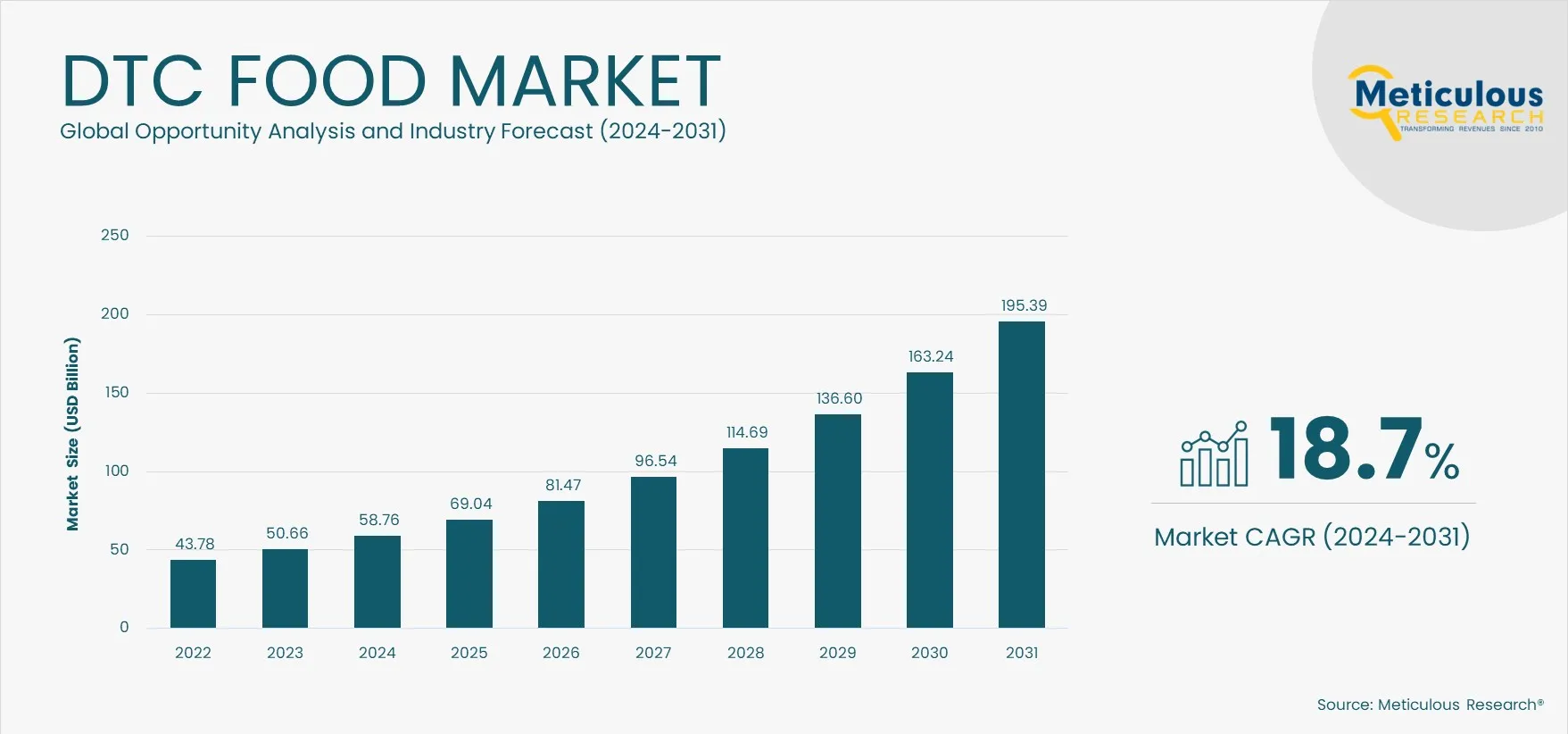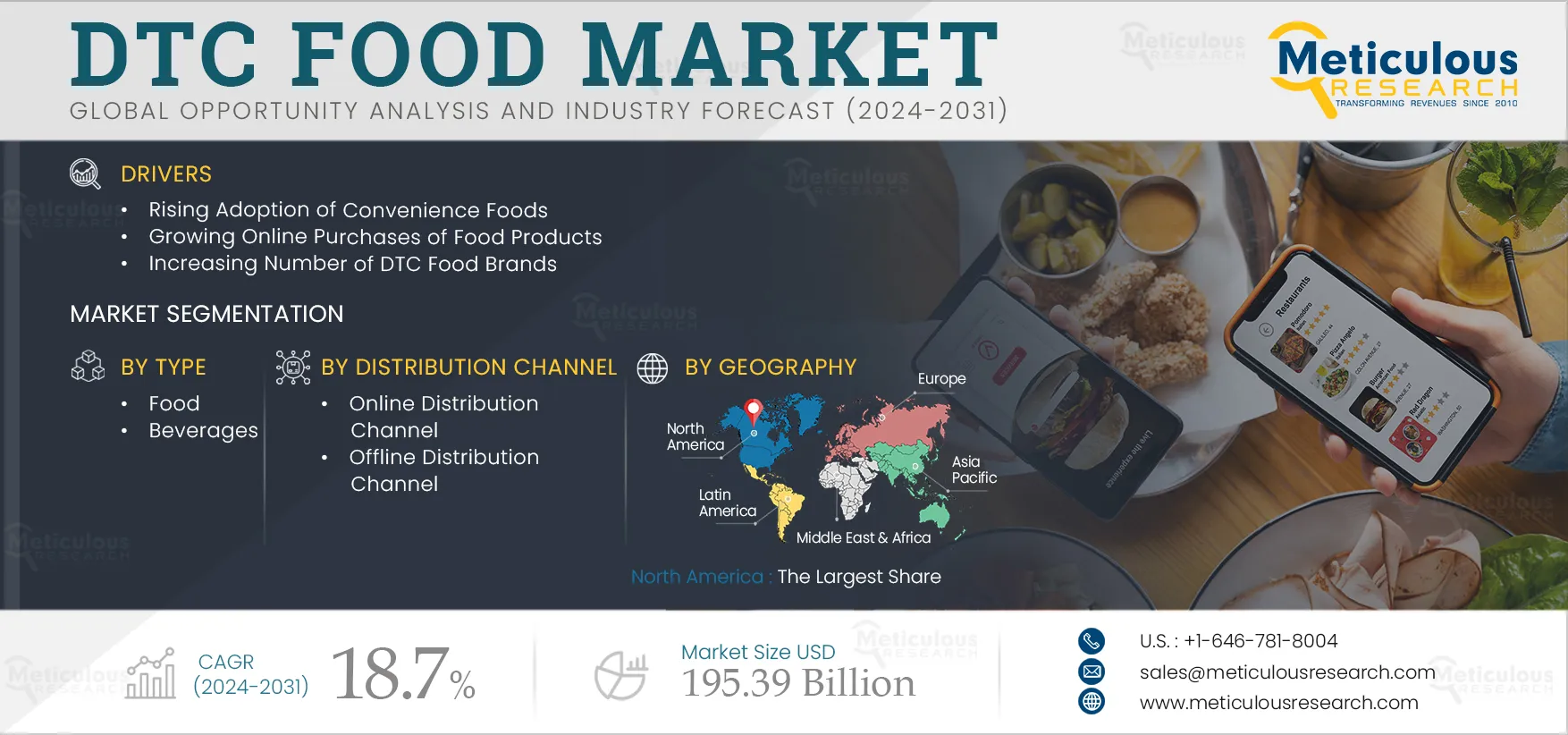The DTC Food Market is projected to reach $195.39 billion by 2031, at a CAGR of 18.7% during the forecast period of 2024 – 2031. The growth of this market is driven by factors such as the rising adoption of convenience foods, growing online purchases of food products, and the increasing number of DTC food brands. However, the lack of brand awareness & limited product offerings of DTC food providers, and product quality concerns & delivery delays are factors restraining the growth of this market to some extent. The growing demand for premium & personalized food products is expected to generate market growth opportunities. However, high competition from other distribution channels is a major challenge impacting market growth. Furthermore, consumers’ increasing focus on health and wellness is a major trend in the global DTC food market.
Here are the top 10 companies operating in the DTC Food Market
Founded in 1965 and headquartered in New York, U.S., PepsiCo manufactures and markets snacks, carbonated and noncarbonated beverages, and food items globally. The company operates through seven business segments, namely, PepsiCo Beverages North America; Frito-Lay North America; Europe; Latin America; Africa, Middle East and South Asia; Asia-Pacific, Australia and New Zealand and China Region; and Quaker Foods North America. Moreover, PepsiCo offers DTC food products under its brands, including Quaker, Health Warrior, Gatorade, Mountain Dew, Cheetos, Lay’s, Ruffles, Chester’s, Health Warrior, Rockstar Energy, and other brands.
The company distributes its products through three distribution channels: direct store delivery (DSD), customer warehouses, and third-party distributor networks. Moreover, the company sells its products directly to consumers through e-commerce platforms and its own brand’s websites, including snacks.com, pantryshop.com, and rockstarnergy.com, among others.
With its subsidiaries and a strong distribution network in over 200 countries, the company has a geographic presence across North America, Europe, Asia-Pacific, Latin America, and the Middle East & Africa.
Nestlé S.A.
Founded in 1866 and headquartered in Vevey, Switzerland, Nestlé manufactures and distributes a wide range of food products. The company’s product portfolio includes milk, chocolate, confectionery, bottled water, coffee, creamer, seasoning, frozen food, and pet foods. The company operates through seven business segments, namely Powdered and Liquid Beverages; PetCare; Nutrition and Health Science; Prepared dishes and cooking aids; Milk Products and Ice Cream; Confectionery; and Water.
Nestlé offers functional food and beverages under its brands Maggi, Nescafe, Vital Proteins, Peptamen, Gerber, NaturNes, Nesquik, and NESPRESSO, among others. The company sells its products through several distribution channels, including supermarkets, hypermarkets, convenience stores, e-commerce, direct-to-consumer platforms, and other distribution channels.
With its subsidiaries and a strong distribution network in more than 188 countries, the company has a geographic presence across North America, Europe, Asia-Pacific, Latin America, and the Middle East and Africa.
Founded in 2012 and headquartered in Illinois, U.S., Mondelēz International, Inc. manufactures and distributes food and beverage products. The company operates through three business segments, namely Biscuits & Baked Snacks, Chocolate, Gum & Candy, Beverages, and Cheese & Grocery. The company offers products such as cookies, crackers, salted snacks, chocolate, candy, cheese, groceries, and beverages.
The company usually distributes its products through supermarket chains, wholesalers, supercenters, club stores, mass merchandisers, distributors, convenience stores, gasoline stations, drug stores, value stores, and other retail food outlets. Additionally, the company also sells products directly to businesses and consumers through various pure-play e-retail platforms, retailer digital platforms, the company’s direct-to-consumer (DTC) websites, and social media platforms.
With 148 manufacturing and processing facilities in over 80 countries, the company has a distribution network spanning 150 countries and has a geographical presence across North America, Europe, Asia-Pacific, Latin America, and the Middle East and Africa.
Anheuser–Busch InBev NV/SA
Founded in 2008 and headquartered in Leuven, Belgium, Anheuser–Busch InBev NV/SA is engaged in the manufacturing and distribution of alcoholic and non-alcoholic beverages globally. The company’s product portfolio includes beer, malt beverages, soft drinks, and other alcoholic beverages. The company offers its products under several brands, including Budweiser, Aguila, Stella Artois, Beck’s, Leffe, Hoegaarden, Skol, Bud Light, Victoria, Harbin, Corona, Brahma, Quilmes, Natural Light, and other brands.
The company markets its products through the DTC distribution model in more than 17 countries. The company’s digital DTC solutions are Zé Delivery in Brazil, TaDa in Latin America and South Africa, and PerfectDraft in Europe. With its subsidiaries and operations in more than 50 countries, the company has a strong geographical presence in North America, Europe, Asia-Pacific, Latin America, and the Middle East and Africa.
Founded in 1892 and headquartered in Georgia, U.S., Coca-Cola manufactures and markets a variety of beverages. The company’s product category includes Trademark Coca-Cola, sparkling flavors, water, sports, coffee, tea, juice, value-added dairy, and plant-based beverages.
In addition, the company distributes several products under various beverage brands, including sparkling soft drink brands (Coca-Cola, Sprite, and Fanta), water, sports, coffee, and tea brands (Dasani, Smartwater, Vitaminwater, Topo Chico, BODYARMOR, Powerade, Costa, Georgia, Gold Peak, Honest Tea, and Ayataka), juice, value-added dairy, and plant-based beverage brands (Minute Maid, Simply, innocent, Del Valle, fairlife, and AdeS), and others.
The company offers its products through a network of independent bottling partners, distributors, wholesalers, retailers, and others. The company also sells its products through direct-to-consumer (DTC) e-commerce platforms, such as miCoca-Cola.cl in Chile and yourcoca-cola.co.uk in the U.K.
With its subsidiaries and strong distribution network in more than 200 countries, the company has a geographical presence across North America, Europe, Asia-Pacific, Latin America, and the Middle East & Africa.
The Kraft Heinz Company
Founded in 2015 and headquartered in Pittsburgh, U.S., The Kraft Heinz Company manufactures and markets food and beverage products. The company operates through two reportable segments by geography, namely North America and International. The company product portfolio includes Condiments and Sauces; Cheese and Dairy; Ambient Foods; Frozen and Chilled Foods; Meats and Seafood; Refreshment Beverages; Desserts, Toppings and Baking; Coffee; Nuts and Salted Snacks; Infant and Nutrition; and Others.
The company offers its products through its own sales organizations and independent brokers, agents, and distributors to wholesale, cooperative, and independent grocery accounts, convenience stores, drug stores, value stores, bakeries, pharmacies, mass merchants, club stores, food service distributors, and institutions, including hotels, restaurants, hospitals, health care facilities and certain government agencies. Also, they sell through various e-commerce platforms and retailers. Heinz has a strong geographic presence across North America, Latin America, Europe, Asia-Pacific, and the Middle East & Africa.
Founded in 1953 and headquartered in Sao Paulo, Brazil, JBS is involved in the processing of animal protein. The company is engaged in processing a range of meats, including beef, pork, lamb, chicken, and hides. The company mainly operates through six business segments: Beef North America, Chicken PPC, Brazil, Seara, Pork USA, Australia, and Others. The company’s product portfolio includes prepared foods, beef, pork, lamb, fish, poultry, leather processing facilities, and cattle & sheep feedlots. Further, the company also operates in segments related to the value chain, such as leather, personal care and cleaning products, collagen, metal packaging, casings, biodiesel, transportation, waste management, and recycling.
JBS S.A.’s distribution channels are primarily through retailers, food service distributors, and restaurants.
JBS has more than 500 production units and commercial offices in over 20 countries. The company has a geographic presence across North America, Europe, Asia-Pacific, Latin America, and the Middle East & Africa.
Unilever PLC
Founded in 1929 and headquartered in London, U.K., Unilever is engaged in the manufacturing and distribution of fast-moving consumer goods. The company operates through five business segments, namely Nutrition, Personal Care, Home Care, Beauty & Wellbeing, and Ice Cream. The company offers DTC food products under its Nutrition and Ice Cream business segments. Additionally, the Nutrition and Ice Cream business segment’s product portfolio includes dressings, functional nutrition, healthy snacking, plant-based meat, scratch cooking aids, tea, and ice cream.
The company has several distribution channels to reach its customers, including hypermarkets, supermarkets, wholesalers, small convenience stores, and e-commerce sites. The company markets its DTC food products through offline stores and online platforms.
With its subsidiaries and strong distribution network in more than 190 countries, the company has a strong geographical presence across North America, Europe, Asia-Pacific, Latin America, and the Middle East and Africa.
Founded in 1992 and headquartered in Ohio, U.S., AriZona Beverages produces and sells a variety of beverage products. The company’s product portfolio includes tea, coffee, snacks, juices, and alcoholic beverages.
The company sells its products through online DTC and retail stores. The company has a geographic presence across North America and Europe.
OLIPOP, Inc
Founded in 2017 and headquartered in California, U.S., OLIPOP, Inc produces soda beverages. The company’s product portfolio includes different flavors of soda beverages, such as classic root beer, vintage cola, lime, orange, ginger, cherry, vanilla, and others. The beverages are made with prebiotics, botanicals, and natural plant fiber to support the microbiome and benefit digestive health. The company sells products through online DTC and retail stores. The company has a geographic presence across the U.S.

























